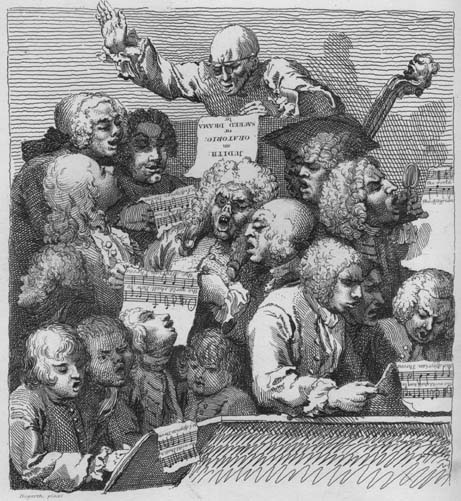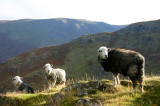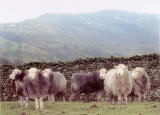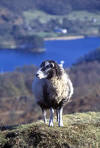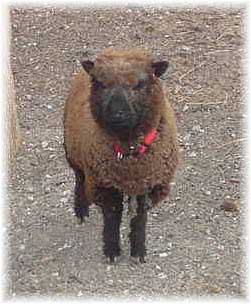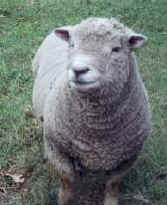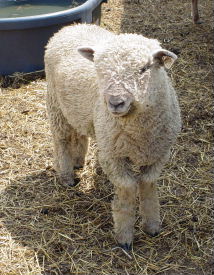| Hogarth: Chorus of Singers |
| Shelwin.com |
|
|
| Sheep | ||
|
|
||
Some notes on favourite species of sheep |
||
 |
||
|
Borrowdale (where you will still find Herdwicks) HERDWICK SHEEP
We have all taken these beautiful beasts for granted over the years and, sadly, it has taken Foot and Mouth disease in 2002 to bring this special breed to the nation's awareness. The following is taken from a pamphlet found in the Tourist Information Centre in Grasmere, Cumbria:
|
||
|
|
||
|
||
|
For a friendly sheep who climbs over your web page, try this little programme. Download it to your desktop, double click and the sheep appears. The more times you click the more sheep you get! Don't worry, they go away when you close down the computer! Right click on the sheep and try different commands (all in Japanese of course, so it's pot luck) and see if you can find the spaceship (and other things besides!) . . . |
||
|
and for bleating sheep, these two .wav
files:
|
||
and for sheep who sing Blake's New Jerusalem . . . try http://www.golakes.co.uk/baarmysheep/ |
||
|
||
|
|
||
|
Visit the
Southdown Sheep Society web site from whence much of the information
below has been gleaned |
||
| HISTORY | ||
|
The
Southdown sheep has roamed the Sussex Downlands from time immemorial. Around
200 years ago, John Ellman of Glynde, near Lewes, in Sussex commenced a
radical improvement of the breed by selection within the breed - no
outcrossing. His work was continued by Jonas Webb of Babraham in
Cambridgeshire, who developed a somewhat larger animal which was used in the
creation of the other Down breeds. The peak of the Southdown's popularity was from about 1790 to the 1914-18 War. During this time they were to be found on many of the large estates in flocks of 1000 or over, as well as being in the possession of yeoman farmers. Although it had been exported to many parts of the world, probably it had its greatest impact in New Zealand, where it was the sire used in the production of the "Canterbury Lamb", a position it held for many decades. The Southdown of today has returned to a larger more
active sheep, partly due to the reintroduction of New Zealand and French
blood. |
||
| FURTHER HISTORY | ||
|
Southdowns have been around for centuries, and their lineage is indisputably ancient, reaching back to a time "older than the peerage". In the nineteenth and twentieth centuries they were to be found in quantity especially in and around the area of the South Downs near Lewes in Sussex, and it was from here they gained their name. It has been estimated that there were some 110,000 sheep in Sussex in 1341 and their wool was second only to the Hereford sheep in fineness and quality. In 1813, nearly five centuries later, the Reverend Arthur Young estimated that there were 200,000 ewes kept on the eastern South Downs and commented that "the amazing number they keep is one of the most singular circumstances in the husbandry of England". The principal reason for the large concentrations of
Southdown sheep on downland farms over these centuries was their crucial
role in the maintenance of soil fertility. The large flocks grazed the open
downs by day and at dusk came down to the lower arable land for folding. The
downland soils tend to be chalky and not naturally fertile so that the
close-folding by the sheep on small areas manured and trod the soil. This
meant that bread wheat could be grown successfully the following year. With
the gradual introduction of new crops such as field turnips, swedes, kohl
rabi and other forage crops the folding system took off as never before,
increasing in parallel with expanding human population. The system reached
its zenith in the 'Golden Years' lasting from about 1845 to 1870 or 80. Then
began the Great Depression. A severe and prolonged fall in the prices of
wool and cereals due to rising volumes of imports from the New Countries was
accompanied by the Wet Years - a six year period of cold wet weather with
little sun. |
||
|
http://wildwnc.org/af/southdownsheep.html
|
||
|
||
|
|
||
|
Going under the name of Baby-Doll Southdowns, certain of the surviving
small, original breed of animal have been exported to America, where there
are now a few farms specialising in what they consider to be miniature
animals. The following is taken from an American web site for Sweetwater
Farm, Maryland, at:
http://babydollsouthdowns.com/history.htm
"One of the oldest of the English Breeds of sheep is the Southdown, originating on the South Down hills of Sussex County, England. These small sheep were know for their extreme hardiness and produced meat with unmatched tenderness and flavor then any other breed of sheep. "In 1780 John Ellman, realized the potential of these animals and set out to standardize the Southdown breed. In England, these small Southdowns grew in popularity up until 1908 when there were approximately 367 registered flocks totalling about 110,000 ewes. The growth in this breeds' development slowed in the early 1900's as World War I brought a sharp decline in their numbers. By the end of the World War II, the demand for larger cuts of meat had almost forced the breed into extinction.
"It is believed that the breed reached the
United States in 1803. Their popularity grew and later declined in nearly
the same pattern that had occurred in England. The small Southdown could not
satisfy the consumer demand for larger meat cuts. This was a significant
factor in the development and mass production of the larger, leggier
Southdown of today. This divergence from the original breed standards was
the beginning of what would later become two distinct lines: The Southdown
and the miniature (or original) Southdown. In breeding for these larger
characteristics however, many of the original "miniature" attributes were
bred out and nearly lost. Each year brought a further decline in the number
of these "original" Southdowns. "In 1986, Mr. Robert Mock began a search for the sheep with the original blood lines and that conformed to the original Southdowns of the 1700's. However, finding them proved to be difficult. At one point they were believed to be extinct. After a four-year search, two small flocks totalling 26 sheep were located; however, this group would not be able to provide a sustainable gene pool. After an extensive search, a total of 350 of these miniature sheep were located. Many of them still carried their original Southdown registration papers. "To distinguish these small sheep from the larger modern-era Southdown, Mr. Mock named them “Olde English Babydoll Southdowns". To keep this line pure, a registration was formed. Only adults two years and older were accepted so that they could be judged against the original conformation standards as verified by a veterinarian. Each sheep's registration application was passed before a board of three members of the Breed Association. After this initial review and acceptance period, the "Foundation Flock" registry was closed in 1991. The term Foundation Flock is still used to refer to this original pool of sheep. "Subsequently, the process of registering lambs from this original foundation flock began. The registry now celebrates many years of success with the preservation of the “babydolls”. It gives my wife and I great pleasure being part of the preservation of this wonderful little sheep. But most of all, they are a wonderful animal to own… " |
||
|
|
